Unusually antibiotic-resistant bacteria were recently identified by the CDC's Antibiotic Resistance Lab Network, according to a report issued by the agency last week. The Vital Signs report noted 220 occurrences in the U.S. of germs, also referred to as "nightmare bacteria," which could not be eradicated by the majority of or by any available antibiotics. Tru-d SmartUVC robot is intended to stifle the spread of antibiotic-resistant bacteria through UVC disinfection in patient rooms, and other hospital areas. A CDC-funded trial of the SmartUVC disinfection robot reduced the risk of acquiring or spreading four key "superbugs" by 30 percent.
CDC infection strategy
CDC employs a containment strategy for antibiotic-resistant pathogens, which involves quickly finding the germs, instituting infection controls, testing asymptomatic patients for the ability to carry the pathogen, and continued assessment and control measures. CDC research found that one-quarter of samples sent to its AR Lab Network had a gene that allowed germs to spread resistance, and facilities with cases of resistant bacteria found one-tenth of screening tests of asymptomatic patients were positive for difficult-to-treat bacteria. However, the CDC's containment strategy was able to reduce infection by as much as 76 percent across three years in a state that implemented the protocols.
"CDC's study found several dangerous pathogens, hiding in plain sight, that can cause infections that are difficult or impossible to treat," said Anne Schuchat, principal deputy director, CDC. "It's reassuring to see that state and local experts, using our containment strategy, identified and stopped these resistant bacteria before they had the opportunity to spread."
Memphis, Tenn.-based Tru-d's SmartUVC system uses ultraviolet light, invisible to humans, as a method to continuously attack pathogens.
"UVC wavelengths are between 200 and 300 nanometers, making them germicidal – meaning they are capable of inactivating microorganisms, such as bacteria, viruses and protozoa," Alice Brewer, director of clinical affairs for Tru-d, told BioWorld MedTech. "Tru-d operates at a consistent 254 nanometers, which is the optimal wavelength for disinfection," offering a chemical-free method to destroy microorganisms, including dangerous ones like methicillin-resistant Staphylococcus aureus (MRSA) and C. difficile, she said.
Infection control without hospital staff
"Tru-d SmartUVC is a portable UV disinfection robot that delivers an automated, measured dose of UVC to consistently disinfect an entire room, resulting in the ability to document disinfection results after each and every room treatment, "said Brewer. "Tru-d operates from a single placement within the room, ensuring significant pathogen reduction in direct and shadowed areas and eliminating the threat of human error in the disinfection process." The device system can be placed as needed in patient rooms or other areas.
"Most hospitals prioritize using Tru-d in isolation discharge rooms, especially C. diff. cases, and nightly terminal cleaning of operating suites," said Brewer. "However, some hospitals use Tru-d in other capacities, including patient rooms, public areas, pharmacy add mix rooms, central sterile departments, outpatient surgery centers, labor and delivery, and more. Decreasing bioburden in all areas of a hospital is key in reducing the risk of infections."
Study results
The cluster-randomized BETR-D (the Benefits of Enhanced Terminal Room Disinfection) study, funded by the CDC, included nine hospitals across Duke Infection Control Outreach Network (DICON) and evaluated strategies for disinfection of terminal rooms for C. difficile, MRSA, multidrug-resistant Acinetobacter, and vancomycin-resistant enterococci. Disinfection was evaluated across four consecutive seven-month time periods in which specific rooms were cleaned by one of four methods: bleach; bleach and UVC; quaternary ammonium disinfectant except for C. diff., which received bleach cleaning; and quaternary ammonium disinfectant and UVC, though C. diff. received bleach and UVC.
Tru-d was chosen for the study due to its prior clinical research, and third-party data, said Brewer. "Tru-d was the only robot that could guarantee an effective baseline of disinfection throughout the room due to its measurement capability through its Sensor360 technology."
Duke applied for and was awarded a $2 million federal assistance application for the study, which included "122,000 patient days; and 22,000 Tru-d disinfection cycles," she said.
During the research, 31,226 patients were exposed to a targeted pathogen and 21,395 were included in the study. Target organisms were lower when UV was added to typical cleaning approaches (n=76; 33 9 cases per 10,000 exposure days; relative risk 0 70, 95 percent CI 0 50–0 98; p=0 036), according to the study. Adding bleach did not significantly impact outcome.
Medical devices and infections
Carbapenem-resistant Enterobacteriaceae (CRE) gained particular attention among the medical device community a couple of years ago with news of infected endoscopes passing the bacteria to patients. The scopes were sterilized between procedures but the process did not effectively rid the devices of the pathogen. (See BioWorld MedTech, June 27, 2016.)
Activity in the space picked up about the same time. Patient Safe Inc., of Sausalito, Calif., launched its Steriview infection control system, which includes Stericam software to confirm surgical tools are free of fluid and bacteria. Prairie Dog Tech LLC, of Philadelphia, also brought its Pd-vision-enabled The Observer infection control app to market to aid hospital workers in cleaning scopes and other devices with an image database and guidelines.
Other companies also have taken aim at disinfection on a larger scale in the hospital. Xenex Disinfection Services LLC, of San Antonio, Texas, offers a portable robot that uses xenon gas to rid an area of bacteria, fungus, mold and viruses. The device, which also was studied with CDC-backed research, is used by hospital staff. Opgen Inc., of Gaithersburg, Md., developed its Acuitas Lighthouse, a multidrug-resistant organism management system for hospitals. The system uses analytics and bioinformatics to monitor infection, and can be accompanied by the company's gene testing to determine who may carry a pathogen.








